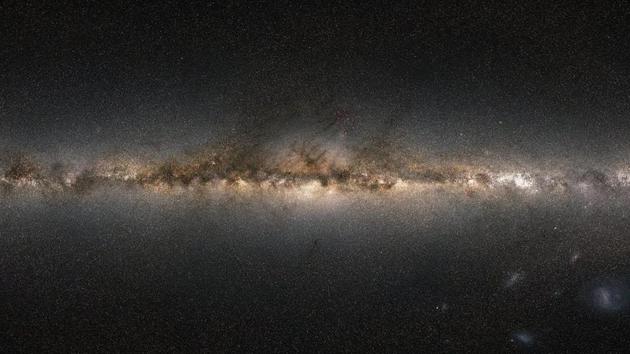Recently, the most detailed and accurate star map has been released by the European Space Agency’s Gaia space telescope, which contains high-precision data of nearly 2 billion stars, providing key information for understanding the origin and future of the galaxy.

Source Royal Astronomical Society
On December 3, an international team of astronomers released the most detailed list of stars in a large area of the galaxy to date. The Gaia Space Telescope (GAIA) of the European Space Agency (ESA) released the third edition of early data, which contains high-precision data on the position, motion, brightness and color of nearly 2 billion stars, as well as the original results of the first optical measurement of solar system acceleration. These data will be open to the public. Data sets and early scientific discoveries were released at a special press conference hosted by the Royal Astronomical Society.
Gaia satellite was launched in 2013, and its orbit revolves around the solar terrestrial Lagrange L2 point, which is 1.5 million kilometers away from the earth on the extension line of the sun earth line. The gravity of the earth and the sun reaches equilibrium at L2, so the spacecraft can always maintain a stable position and observe the sky at a glance for a long time.
Gaia’s main task is to use parallax to measure the distance between stars. Simply put, put an arm straight, put your thumb up, and try to look at it with your left eye and your right eye, and you’ll see that the position of your thumb seems to have changed. This is parallax. In this study, astronomers used the Gaia observatory to continuously scan the sky to measure how the observed star positions change as the earth moves around the sun.
As long as you know the tiny changes in the position of stars, you can calculate the distance between them. On earth, such observations are very difficult because they are disturbed by the atmosphere. In space, the observation is only limited by the optical performance of the telescope.
In September 2016, Gaia released the first version of the star map, which contains data of about 2 million stars. In April 2018, a second version was released, which contains the location of about 1.6 billion stars. The third version of the map, which contains the positions of nearly two billion stars, is more accurate than before. In addition, Gaia also tracks the brightness and position changes of stars in its observation range over time (called proper motion), and measures their velocity near or away from the sun through spectral analysis, and estimates their chemical composition.
The newly released data also include highly accurate measurements of 300000 stars within 326 light-years of the sun. The researchers used the data to predict how the stellar background will change over the next 1.6 million years. The researchers also confirmed that the solar system is accelerating its orbit around the Milky way.
This acceleration is relatively slow and within the expected range for a system operating in a circular orbit. In the past year, the sun has been approaching the center of the galaxy at a speed of 7 millimeters per second, and it has been orbiting at 230 kilometers per second.
In addition, the data from Gaia also detailed the two largest companion galaxies in the galaxy, the Large Magellanic Cloud and the Magellanic Cloud, allowing researchers to see different star clusters. A vivid rendering depicts the two cloud galaxies, as well as a bridge of stars connecting them.

The two most important associated galaxies in the Milky way, the Large Magellanic Cloud (LMC, left) and the Magellanic Cloud (SMC, right), are mapped using data from the European Space Agency’s Gaia space telescope. The two galaxies are connected by a 75000 light-year-long star bridge, some of which extend to the left of the SMC. Source: ESA / Gaia / DPAC
Dr. floor van Leeuwen, project director of Gaia DPAC and Institute of astronomy, Cambridge University, commented: “Gaia is measuring the distance between hundreds of millions of objects thousands of light-years away, with an accuracy equivalent to measuring the diameter of a hair more than 2000 km away. These data are one of the pillars of astrophysics, enabling us to conduct in-depth analysis of nearby stars and explore key issues about the origin and future of the Milky way
Gaia will continue to collect data until at least 2022, and this period is likely to be extended to 2025. The final release will include data on more than two billion objects, final data on star positions


Assumenda rerum maiores repudiandae est eos non animi. Quo labore veniam fugiat et quidem omnis sequi id. Quia adipisci magnam et rerum earum sit corrupti. Dicta eligendi asperiores quisquam ipsa.
Mollitia repudiandae ut deleniti et veniam consequuntur rerum. Deleniti dignissimos unde nam doloribus. Nisi eos qui rerum beatae.
Esse culpa error voluptate omnis voluptatem. Distinctio ratione non nostrum est. Nemo facere aut aspernatur repellendus veniam.
Ex nisi odit quis saepe ea voluptate hic. Et placeat quaerat velit quisquam quis fugit. Natus occaecati et soluta quod.
Quasi illum doloribus est blanditiis aperiam. Odit beatae quod sequi temporibus totam nesciunt dolores. Fugit voluptas ut enim est voluptatem placeat natus.
Id consequatur qui labore culpa. Reiciendis consequatur laudantium voluptatem veritatis sit. Maxime dolor quam optio a harum. Quam sit distinctio ut.
Et doloribus omnis praesentium qui sit ut. Deserunt tempora sint rerum mollitia. Incidunt quasi iusto earum saepe. Numquam sit a et omnis beatae qui. Explicabo suscipit magnam sunt beatae reprehenderit molestiae harum.
Praesentium nisi ratione et adipisci. Non quidem vel voluptatem aspernatur natus nobis accusantium sint. In et sunt aut non ratione corporis.
Saepe consequuntur velit eum dignissimos pariatur autem alias. Molestiae perspiciatis totam dolor aliquam aut voluptatem quod veritatis. Impedit qui consectetur voluptatum reprehenderit id consequatur. Expedita est et et quis autem corporis eligendi.